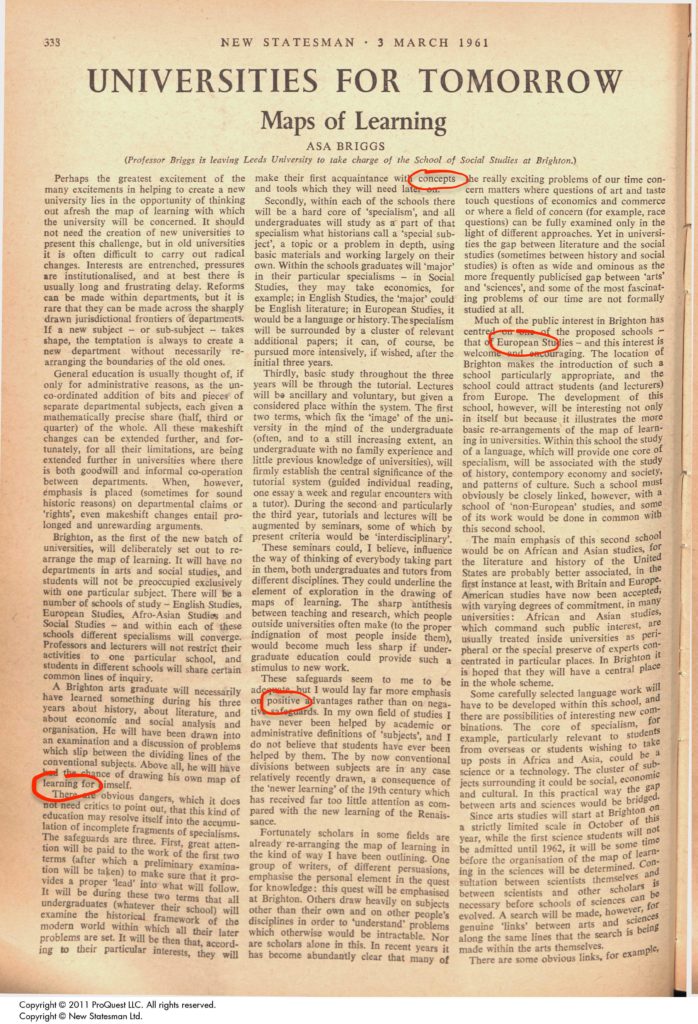
In this case study, Dr Katie Piatt, Head of Educational Enhancement and co-Chair of the Playful Learning Association, talks about how she developed an escape room for the University Pasts and Futures conference as a fun way to introduce students and staff to the work of Asa Briggs.
What I did
I designed and implemented an escape room for the Universities Past and Futures conference held by the School of Media, Arts and Humanities in September of 2023. This conference set out to explore what we can learn about the past of the University and how we can imagine its future by exploring the archives and showcasing the history of the University’s people and architecture. I wanted to introduce participants (students and staff) to Asa Briggs, who was a professor of history at Sussex and served as dean, pro-vice chancellor and vice-chancellor. Reflecting on his time at Sussex, Briggs stated that he had more pleasure intellectually forming the University of Sussex than all his other experiences to date (Field, 2011). Briggs’ passion for the University and his storied history working for Alan Turing’s code-breaking team at Bletchley Park inspired my idea to introduce his role at Sussex through an escape room. Assisted by my parents, who studied at Sussex, and members of the EE team, I located a variety of archival materials related to Briggs’ time at Sussex. Using these materials, I designed puzzles that would familiarise players with some code breaking techniques. We ran the session five times across the day so that different groups could participate.


Why I did it
Playful learning helps to create safe learning environments in which learners are empowered to work together, take risks and build resilience. By creatively exploring new possibilities and ways of being, students are more likely to remember what they have learned. I thought that an escape room would be an ideal way to exemplify playful techniques in education and used this event to demonstrate how we can explore University history in different ways. I also wanted to provide a team bonding experience that enhanced communication skills and an understanding of each other’s strengths. I designed this escape room to showcase the benefits of playful learning, but I also wanted to provide participants with a novel example of open scholarship, demonstrating different ways of teaching and knowledge exchange using University archives.

Impact and student feedback
Participants really enjoyed the experience and commented that it would be good for students as a way of learning. They noted that the theme of the escape room and the problems that it involved complemented the conference presentations and enabled them to engage with the ‘map of learning’ in an interactive way. I was really pleased with how the escape room provided an opportunity for conference participants to get to know each other and work together to solve problems, which provided a more meaningful way to make new connections than a typical meet and greet.
Challenges
Designing the escape room for the right level was a challenge. My expectation was that most participants would be beginners, so I did not want the puzzles to be overly difficult. This is why it is important to test the escape room with participants before implementing it at your event or in the classroom. Designing the escape room for a particular time slot was also challenging. We wanted participants to attempt the breakout room between the different conference sessions, which meant that I had to reduce the number of problems so that participants did not feel rushed. Although I designed this escape room as a short fifteen-minute activity, it could be extended to work as a longer activity for students in class.
Future plans
I plan on keeping this as a resource to demonstrate playful learning through escape rooms and as an example for others to think of designing their own.
Top tips:
- Make sure to run lots of testing on your puzzles—what is obvious to you is not to everyone else and it spoils the fun if people get frustrated.
- Don’t overcomplicate it! Remember the aims and plan each puzzle around that. It is tempting to add red herrings and lots more archive material, but this just takes longer to plan and makes it harder for players
- Borrow do not spend! There are lots of materials that can be used as props around the university. Reach out to the Educational Enhancement team who can help lend you boxes and padlocks and old typewriters or whatever you need.
- Make and test your reset plan! As this activity was being run repeatedly through the day, we needed a plan to reset things as quickly as possible. For example, the order you need to local keys back inside boxes is critical.


Leave a Reply